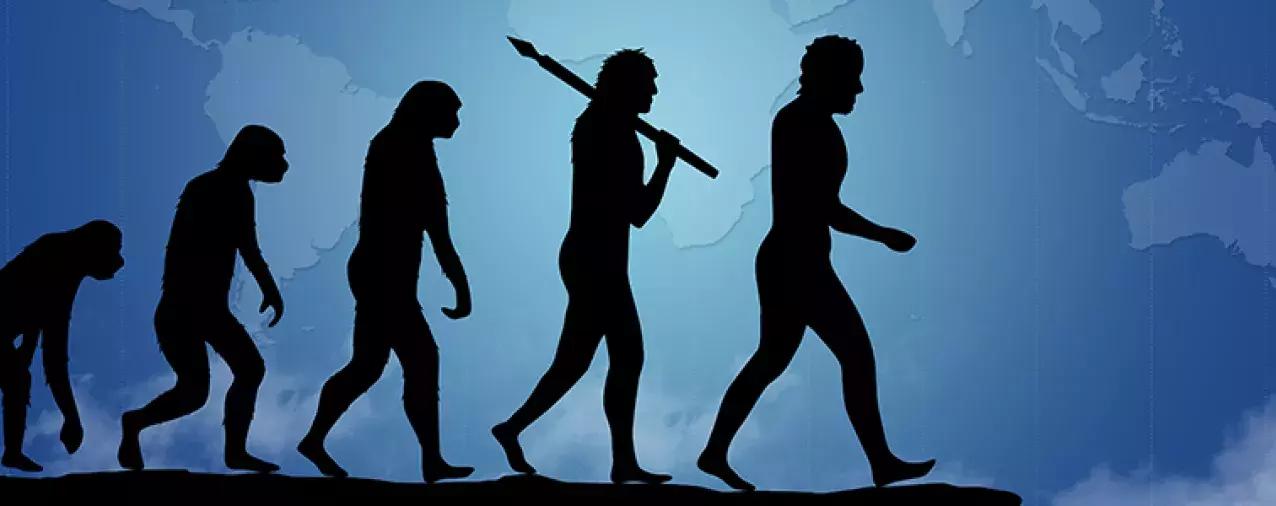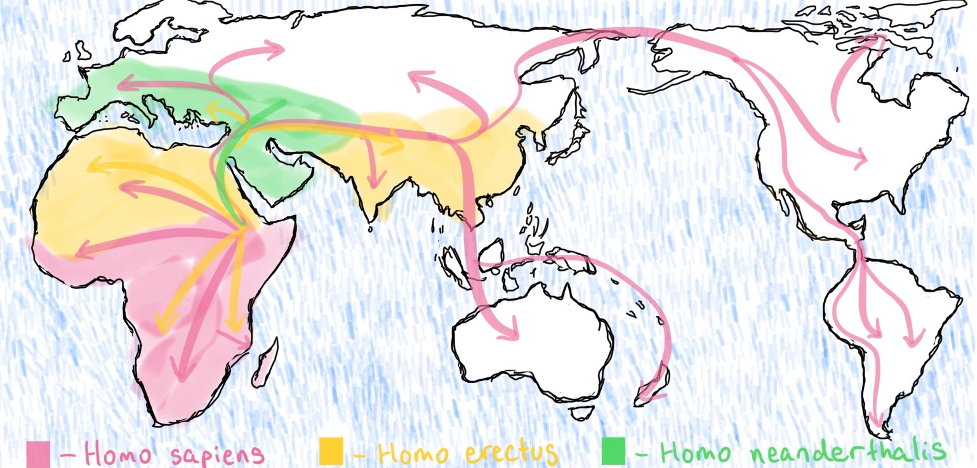Genomics: Insight

Hominid Development, the Great Human Migration, and the Concept of Race
Hypothesis
Measuring inter-continental genetic variations in the context of hominid development, migration out of Africa, and their subsequent adaptations to different regions of the world have shown that popular classifications of race are purely social, and not biological concepts.

Figure 1. Artistic representation of the migration patterns of Homo sapiens, Homo erectus, and Homo neanderthalis superimposed on world map (created by author using Adobe Sketch).
Introduction
A member of Australopithecus afarensis walks, upright, through her territory in the ancient riverine forests of Eastern Africa. Stepping through the verdant brush on arched feet and a bipedal pelvis, she climbs up a tree with ease, grasping a fruit with her curved fingers. Reaching the edge of her wooded habitat, she stands and gazes out across the vast, lush Saharan grasslands. 1
Since these first ape-like proto humans looked out towards the horizons of new continents, hominids have dispersed to every corner of the Earth. Alongside now extinct human species like Homo erectus and Homo neanderthalensis, Homo sapiens dominated the planet through shockingly rapid development and technological advances and disseminated to almost every other continent from their origins in Eastern Africa. Humans have since developed agriculture, built civilizations and created societies through rigid structures like wealth, class, and race. The relatively recent concept of race, categorizing people based on arbitrary traits such as appearance or skin color, was used to maintain a social hierarchy and justify certain groups asserting control over or subjugating others. However, modern genomic analyses in the context of hominid development, migration out of Africa, and their subsequent adaptations to different regions of the world show that conventional definitions of race are invalid.
Background
Around 4 million years ago, Australopithecines developed into the first, mostly bipedal hominids. This allowed them to thrive in both dense forests and open plains, greatly assisting survival in a fluctuating climate, associated with up to 5°C global cooling, and a 200- to 300-mm/year rainfall increase at around 3.3 mya.2 By evolving increasingly larger craniums, developing tools and rudimentary family and social structures, Australopithecines diverged into the multiple early human species which spread throughout Africa. 3 By 1.89 million years ago, Homo erectus became the first modern humans to leave Africa and disperse throughout Eurasia, as far as Southeast Asia. Genetic analysis of fossils show that Homo sapiens emerged in Southern Africa as a distinct species by 150,000 years ago and began major migration waves out of Africa 100,000 to 50,000 years ago, alongside multiple other Homo species like Homo habilis, Homo heidelbergensis, and Homo neanderthalis.4 Although the exact scale and timeframe of these migrations is unclear, fossil records from 106–29 thousand years ago demonstrate Homo sapiens, along with other human species, most likely migrated out of the Horn of Africa through the Arabian Peninsula, expanded further simultaneously into Eurasia and Southeastern Asia, Australia and the Americas in response to global and localized, abrupt climate events. 2
Data
Multiple methods to quantify genetic variation in relation to the African Exodus can be utilized to analyze the genetics of “race”. As human origins and development in Africa has been established, methods include measuring SNP haplotype heterozygosity in a population as a function of distance to Africa can be an accurate measure of genetic diversity.
Analyzing genetic diversity and interpreting “race” first requires familiarity with inheritance. Alleles are the variant forms of a specific gene which inhabit the same region on a chromosome. All individuals inherit two alleles from their parents, one from the mother and one from the father. Alleles can be dominant or recessive, in which the phenotype associated with the dominant alleles is expressed, if even the individual inherits one dominant and one recessive allele, or heterozygous individuals. Heterozygosity measures the proportion of heritable variations in a population with heterozygous inheritance. Haplotypes are associated blocks of variant sequences directly passed on from a single parent. The longer a large population has been breeding and evolving together allows for more heterozygosity due to greater opportunity for mutations to occur and be selected for and for recombination events to occur. This increases the proportion of heterozygous loci, therefore a relatively accurate measure of genetic variability. A figure from research reference6, plots haplotype heterozygosity of various populations as a function of distance from East Africa. It demonstrates the decreasing haplotype heterozygosity as distance away from Africa increases, or decreasing genetic diversity outside Africa in the order of Central Asia, Western Asia, Europe, East Asia, Polynesia and the Americas. Comparing haplotype variation among populations also supports out-of-Africa migration and suggests that the populations which first colonized Eurasia was relatively large but isolated from Africa. This demonstrates that there is much greater genetic diversity within the African continent relative to others. Due to this, categorizations of race based on continental, geographical distribution or appearance are inaccurate and unfounded as human genetic diversity was influenced by initial development and diversification within Africa and subsequent expansion patterns to the rest of the world.
Over time, as continents disassociated and Homo sapiens adapted to their individual regions and interbred with other hominid species before they went extinct, humans developed distinct traits which best benefitted survival in their respective regions. For example, traits such as large noses to heat up frigid Northern air in Neanderthals, and dark skin, brown hair, and brown eyes of Denisovans have been integrated into the human genome.5 These superficial adaptations and specializations to the environment became the basis for the current definition of race, which was first conceived during the 17th century by European colonizers. As these aesthetic traits are often attributed to different races, tracing the appearance of mutations and introduction of traits from other Homo species can demonstrate the approximate path and timeline of these traits, and therefore disprove reliance on physical appearance to define race.
Mutation in SLC24A5 gene approximately 300,000 years ago led to lighter skin color in northern Europeans and Southeastern Asians, a trait which better promoted vitamin D synthesis, and therefore positively selected for in regions with low ultraviolet light exposure which occurred. By 60,000 to 80,000 years ago, around the initial waves of migration out of Africa, mutations associated with light skin color swept to nearly 100 percent frequency in non-Africans, one of few examples of a "selective sweep" in all Eurasians.5 Measuring mutation dispersal patterns and selective sweep pathways are comprehensive methods to trace the developments of certain traits associated with race.
Conclusion
Quantifying genetic diversity and random mutations associated with hominid evolution and human migrations out of Africa shows that physical traits develop in response to environmental and natural selective pressures, and that “race”, grouping people based on geography or appearance, is inaccurate in a genetic context. From millions of years of evolution, surviving massive climate upheaval, outcompeting every other species of humans which took eons longer to develop, and completely transforming the planet in a remarkably short period of time, Homo sapiens demonstrated the intelligence, resilience, and ingenuity to thrive, while other species perished. Despite humanity’s achievements, the idea of race, which has created so much conflict, struggle and inequality throughout brief human history is exactly that, an idea fundamentally created and imposed on by human society. Genomic analysis of genetic diversity and various other data-based factors and contexts have established that race is simply justification for outdated stereotypes and biases against certain peoples. Exploring race and society from a quantitative, genomics perspective can successfully challenge the validity of this artificial construct rooted in discrimination, re-examine the profound role of race in our societies, and inform the transition to social relations founded on equity and respect - regardless of ancestry, origins, or appearance.
Sources
- Kimbel, W.H. and Delezene, L.K. (2009), “Lucy” redux: A review of research on Australopithecus afarensis. Am. J. Phys. Anthropol., 140: 2-48. doi:10.1002/ajpa.21183 https://onlinelibrary.wiley.com/doi/abs/10.1002/ajpa.21183
- R. Bonnefille, R. Potts, F. Chalié, D. Jolly, O. Peyron High-resolution vegetation and climate change associated with Pliocene Australopithecus afarensis Proceedings of the National Academy of Sciences Aug 2004, 101 (33) 12125-12129; DOI:10.1073/pnas.0401709101 https://www.pnas.org/content/101/33/12125
- Schlebusch; et al. (3 November 2017). "Southern African ancient genomes estimate modern human divergence to 350,000 to 260,000 years ago". Science. 358 (6363): 652–655. Bibcode:2017Sci...358..652S.
- Timmermann, A., Friedrich, T. Late Pleistocene climate drivers of early human migration. Nature 538, 92–95 (2016). https://doi.org/10.1038/nature19365
- Paul D. Bons , Catherine C. Bauer, Hervé Bocherens, et al Published: April 23, 2019 Out of Africa by spontaneous migration waves https://doi.org/10.1371/journal.pone.0201998
- Xing J, Watkins WS, Shlien A, et al. Toward a more uniform sampling of human genetic diversity: a survey of worldwide populations by high-density genotyping. Genomics. 2010 https://pubmed.ncbi.nlm.nih.gov/20643205/
About the Author
JiaJia Fu is a junior student at Whittle School and Studios who is deeply passionate about science, culture, and history. She aspires to one day create breakthrough solutions for global ecological problems like plastic pollution, intensive agriculture, and climate change through biotechnology.